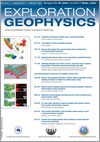
Exploration Geophysics
Volume 45 Number 3 2014
Featuring papers from the 22nd ASEG Geophysical Conference and Exhibition, February 2012
EG13064Prediction and removal of rotation noise in airborne EM systems
Limitations to conductive target detection in AEM systems come from the high noise encountered at low base frequencies, caused by rotations of vector magnetic field sensors in the Earth’s magnetic field. We use rotation-rate sensors to predict and subtract the rotation noise from rigidly coupled ARMIT magnetic field sensors.
Analysing seismic data for direct hydrocarbon indicators (DHIs) and amplitude variation with offset (AVO) can be instrumental in identifying the presence of hydrocarbons. Inversion converts seismic data into acoustic impedance, which can be used to estimate geological properties. This paper reviews the literature and commonly used techniques for seismic amplitude analysis.
EG13078Seismic-while-drilling data processing with seismic interferometry in the Daqing Oilfield experiment
This paper discusses the methods and applications of seismic interferometry in seismic-while-drilling (SWD) experiments. The results show that the deconvolution method can suppress the source effects and enhance the resolution of the results.
EG13059Optimised edge detection filters in the interpretation of potential field data
A new format of edge detection filter, called the optimised edge detection filter, is presented, which produces maximum values only when the horizontal derivative is a maximum and the vertical derivative is zero. These new filters will not produce spurious edges like those in other methods.
EG14011Identifying damaged areas inside a masonry monument using a combined interpretation of resistivity and ground-penetrating radar data
This study shows results of ground-penetrating radar and electrical exploration surveys, and an interpreted section of the internal structure and moisture distribution in the Bayon Complex in the Angkor heritage site, Cambodia. Rainwater penetrates into the monument through gaps between stone blocks and drains from vertical walls through cavities in the top part.
EG12041Airborne electromagnetic detection of shallow seafloor topographic features, including resolution of multiple sub-parallel seafloor ridges
An airborne EM survey over shallow waters in Backstairs Passage, South Australia, detected a mini-seamount and a series of sub-parallel seafloor ridges that vary in peak height and inter-peak spacing. The interpreted resolution of these ridges based on 1D and 3D inversion is consistent with the expected EM footprint.
EG12072Efficient forward modelling using the self-consistent impedance method for electromagnetic surface impedance
The two-dimensional self-consistent impedance method was used to calculate the electromagnetic surface impedance above subsurface structures at very low frequencies. The technique has been applied to the analysis of a coal seam with various structural anomalies and line of oxidation. This improved technique allows in-field inverse modelling of surface impedance data.
EG13050Bathymetry, electromagnetic streamlines and the marine controlled source electromagnetic method
Ocean bottom topography significantly influences the application of marine controlled source electromagnetics. Distortions in the electromagnetic field shape and behaviour associated with the airwave, bathymetry and potential hydrocarbon targets can be observed using streamlines and can point towards survey designs that may not have been considered.
EG12085Pre-stack depth migration for improved imaging under seafloor canyons: 2D case study of Browse Basin, Australia
Complex seafloor topography causes problems with seismic imaging related to complex ray paths and sharp lateral changes in velocity. This paper describes the reasons for some of these problems and a selection of imaging techniques, with their pros and cons, in the presence of seafloor canyons.
EG12082Fault and dyke detectability in high resolution seismic surveys for coal: a view from numerical modelling
We use numerical modelling in an ideal noise-free environment and homogeneous layering to investigate the detectability of small faults by seismic reflection surveying. It is shown that the detection of faults relates not only to the seismic wave frequencies and wavelengths, but also to the presence of background structures.
EG12080Prestack time imaging algorithm with simultaneous velocity estimation in hard rock environments
This paper describes prestack time migration with simultaneous velocity estimation. The approach is based on an estimation of horizontal slownesses and a subsequent calculation of the migration attributes to obtain a migrated image. The potential application of the method to hard rock seismic exploration is demonstrated on synthetic models.

